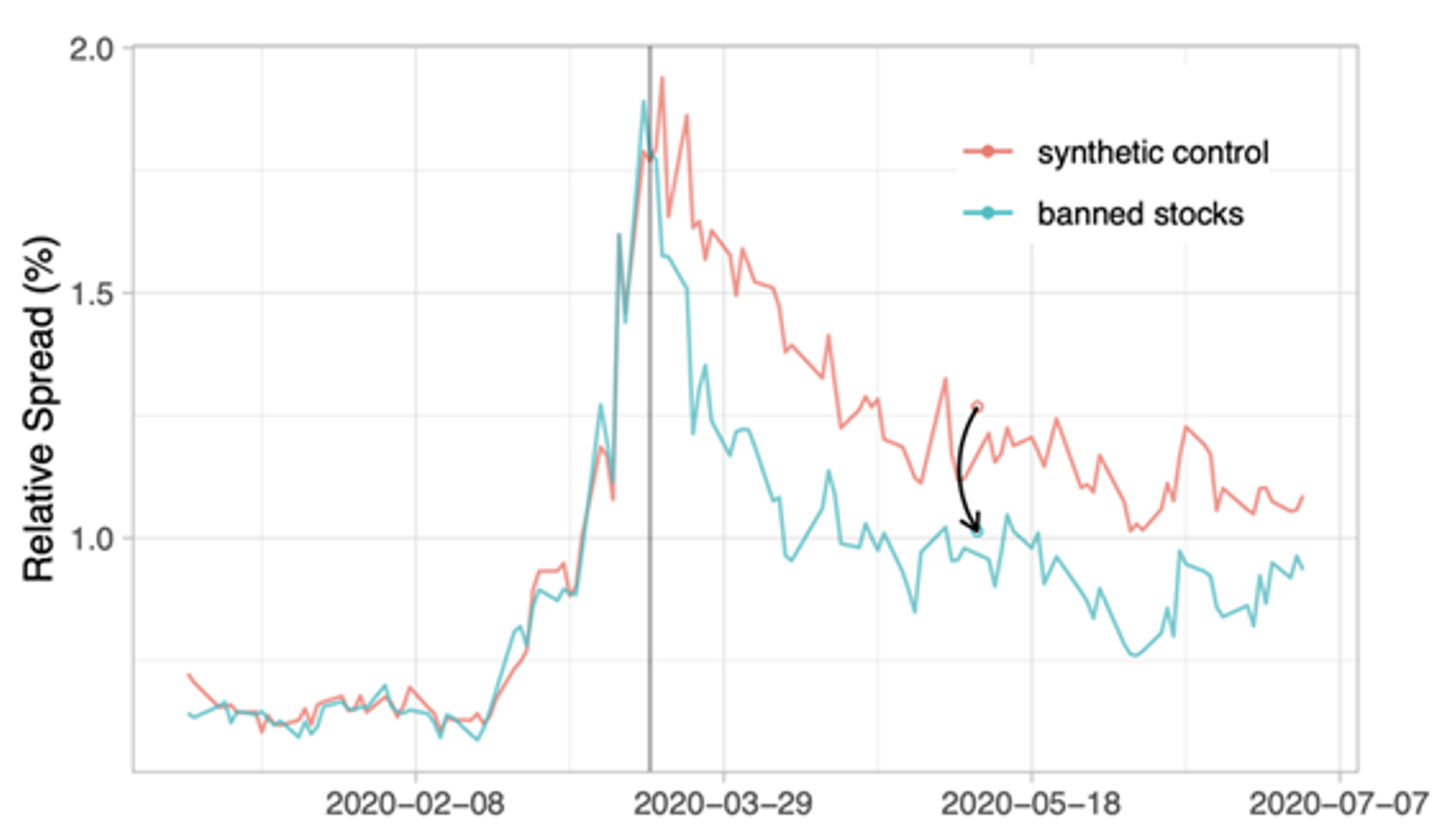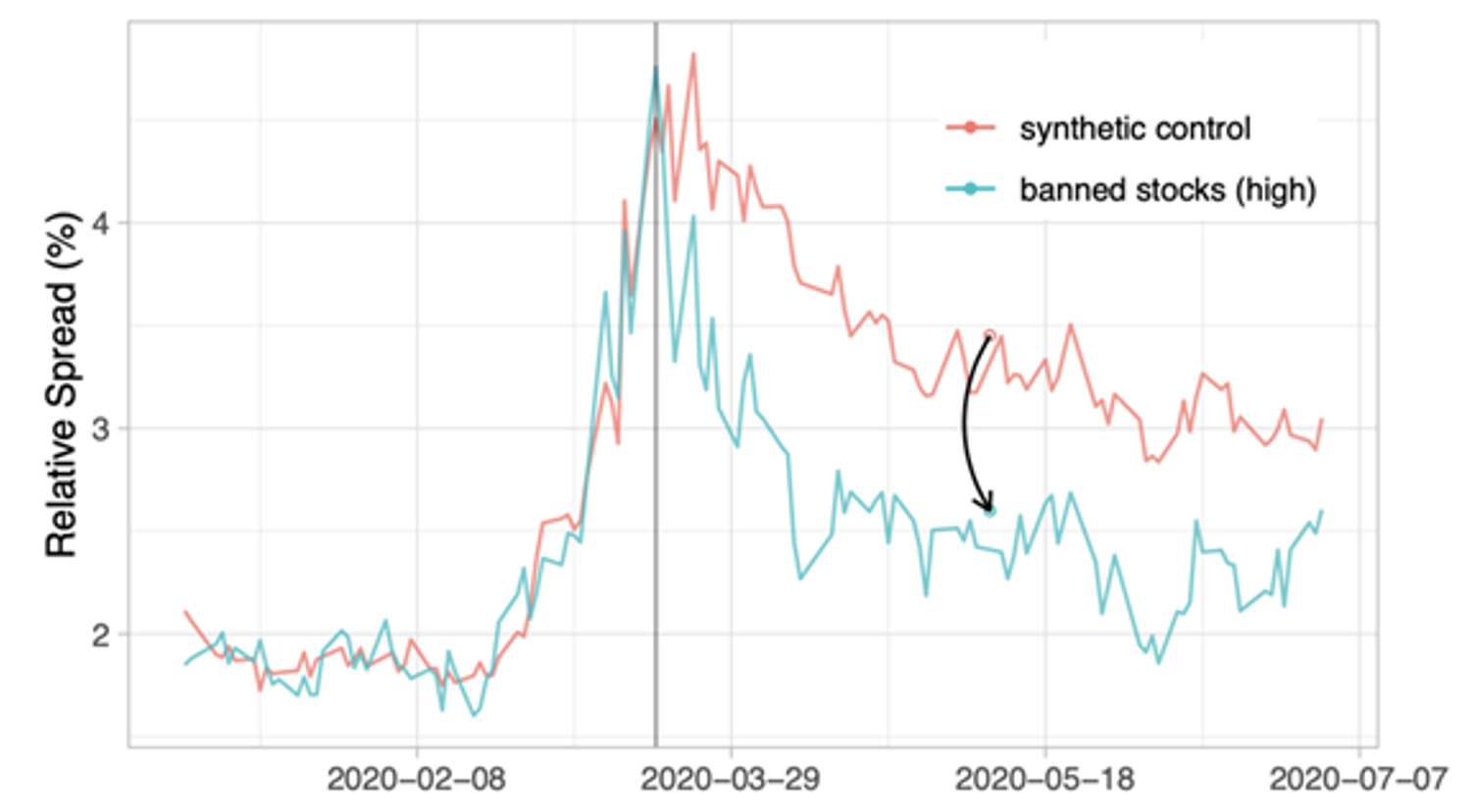In times of instability in financial markets, observers often point to short selling as exacerbating, or in some cases even instigating, downward price spirals. As a result, regulators in several countries have imposed short sale bans in response to crises, such as the 2008-09 financial crisis, the 2011-12 European debt crisis, and – most recently – in the initial phase of the Covid-19 pandemic in the spring of 2020. Although both proponents and detractors agree that these bans restrict trading activity and may cause prices to deviate from fundamentals, the two sides diverge on whether this is a desired effect or an unnecessary distortion, and whether bans improve or harm markets overall.
Several studies on the effects of past bans conclude that these policies largely failed to support prices and reduced liquidity overall (Beber and Pagano 2010, 2013). Studies by Siciliano and Ventoruzzo (2020), Losada and Martinez (2020), Bessler and Vendrasco (2021, 2022), and Le Moign and Spolaore (2022) show similar effects for the 2020 European ban as well. These results are consistent with the perspective that short selling improves market efficiency and that restricting this activity can only harm liquidity. Indeed, as shown in Lenkey (2021), short selling restrictions can reduce efficiency even if non-binding and non-prohibitive. A dual shortcoming of these empirical studies is that they struggle to show causation and largely skirt the issue of informed trade.
In contrast to the market efficiency argument, another strand in the literature explores the notion that short sellers tend to be informed traders whose presence causes market participants to widen spreads. Short sale bans may therefore disproportionately remove informed traders from the marketplace and thus increase liquidity in affected stocks (Diamond and Verrecchia 1987, Appel and Fohlin 2010) In extreme cases, short sales can be construed as the type of predatory trading behaviour outlined in Brunnermeier and Pedersen (2005). Indeed, Boehmer et al. (2020) show that short sellers do hold information with significant predictive value, and Goldstein and Guembel (2008) show that selling can profitably manipulate markets in a way that buying cannot. As shown in Liu (2015), short selling of bank stocks can lead to runs which then creates a feedback loop that can drastically increase the likelihood of a collapse. Further evidence from Tian et al. (2021), building upon the asset bubble model of Scheinkman and Xiong (2003), shows that short sale bans have a temporary price effect that gradually dissipates, converging to zero by expiration. In a study of short selling in Hong Kong, Crane et al. (2019) use the eligibility thresholds imposed by the regulator to identify causal effects and find that bans on short selling did not affect stock price levels or volatility.
It turns out that the Covid crash policy response presents us with an opportunity to identify causal effects of short sale bans (Fohlin et al. 2022). National regulatory authorities typically operate without coordination, and in doing so, have provided us with a convenient natural experiment, comparing markets in countries that implemented bans to similar ones that did not. By February 2020 the Covid-19 virus was spreading rapidly across the globe, and on 24 February stock prices began to decline rapidly. That downward trend continued into late March, precipitating fears of a prolonged recession. In response, regulatory authorities in six European countries implemented short sale bans of varying duration and scope. To measure the effect of these market interventions, we use a difference-in-differences model by comparing various measures of liquidity, as well as prices and volatility, for stocks affected by the short sale ban with those of comparable stocks that were not affected by the ban.
Since it proves impossible to establish an exactly matching control group for banned stocks – and we determined that the banned and unbanned stocks follow somewhat different time trends before the short sale ban – directly comparing them could lead to biased regression results. To fix this issue, we use the method of synthetic difference-in-differences (Arkhangelsky et al. 2021) to construct a control group that mimics the time trend of the banned stocks before the bank by adjusting the weight of each unbanned stock. Having created a synthetic control group that follows the same trend as the banned group before the ban, we can better evaluate the impact of the ban by comparing the post-ban trends with the synthetic control group.
We also consider the possibility that the short sale ban could improve or reduce liquidity for particular stocks depending on a priori characteristics. Given the link between short selling and informed trading, we postulate that stocks with higher relative spreads will be those with a greater proportion of informed short sellers, and hence a ban will serve to limit informed or predatory trading and improve liquidity. Conversely, stocks with lower relative spreads have comparatively fewer informed traders, and the effect of a ban would primarily be to increase order processing costs and increase spreads. To test our hypothesis of heterogeneous impacts of bans, we divide the stocks into three groups ordered by liquidity (relative spread). If, as anticipated, the higher spread stocks see proportionally more activity from informed traders, then imposing the ban should reduce their spreads as short sellers are driven away, while for lower spread stocks, the effect would only be to increase order processing costs and thus increase spreads.
Beginning on 13 March, Italy and Spain imposed a one-day ban on short selling for targeted stocks, followed on 17 Мarch by similar one-day bans in Belgium and France while Spain imposed a long term ban due to last until 17 April. On 18 March, Austria, Belgium, France, Greece, and Italy all followed suit and imposed long term bans due to expire between 16 April and 18 June. Through coordination under the European Securities and Markets Authority, the different timetables initially set by each country were brought into alignment with all of the bans expiring on 18 May. The timing of these bans is summarised in Le Moign and Spolaore (2022). By this time, stock markets had largely recovered and thus the restrictions were deemed unnecessary.
We find that the ban produced a mild but significant reduction in spreads overall, and we can infer that banning short sales led to an improvement in liquidity.
Figure 1 Relative spreads (all stocks)
The sub-group results are even more illuminating, indicating that the ban significantly reduced spreads for the high-spread group, while it increased spreads for the mid and low-spread groups, albeit to a lesser degree. This conforms to our prediction that the ban would improve the liquidity of high-spread stocks but would primarily increase order processing costs and raise spreads for low-spread stocks.
Figure 2 Relative spreads: High-spread group
Figure 3 Relative spreads: Mid-spread group
Figure 4 Relative spreads: Low-spread group
These results can be visualised by looking at the average spreads of the control and treatment groups in Figure 1. We see that while the onset of the pandemic greatly increased spreads for both groups, spreads on the stocks subject to the short sale ban subsequently dropped rapidly, while those of unbanned stocks remained well above their pre-pandemic levels, and that effect continued past the end of the ban.
The analysis offers a more robust test of the impact of short sale bans by segmenting the population according to a priori liquidity class and by creating a quasi-experiment with the use of more closely matched ‘synthetic’ controls for the treatment group. Our results offer useful policy implications for regulators to consider in refining their approach to financial market instability when the next crisis hits.
References
Appel, I and C Fohlin (2010), “’Shooting the Messenger?’ The Impact of Short Sale Bans in Times of Crisis”, Working Paper.
Arkhangelsky, D, S Athey, D A Hirshberg, G W Imbens and S Wager (2021), “Synthetic difference-in-differences”, American Economic Review 111(12): 4088–4118.
Beber, A, D Fabbri, M Pagano and S Simonelli (2021), “Short-selling bans and bank stability”, The Review of Corporate Finance Studies 10(1): 158–187.
Beber, A and M Pagano (2010), “Short-selling bans in the crisis: A misguided policy”, VoxEU.org, 6 February.
Beber, A and M Pagano (2013), “Short-selling bans around the world: Evidence from the 2007–09 crisis”, The Journal of Finance 68(1): 343–381.
Bessler, W and M Vendrasco (2021), “The 2020 European short-selling ban and the effects on market quality”, Finance Research Letters 42, 101886.
Bessler, W and M Vendrasco (2022), “Short-selling restrictions and financial stability in Europe: Evidence from the Covid-19 crisis”, Journal of International Financial Markets, Institutions and Money 80, 101612.
Boehmer, E, C M Jones, J Wu and X Zhang (2020), “What do short sellers know?”, Review of Finance 24(6): 1203–1235.
Boehmer, E, C M Jones and X Zhang (2011), “Shackling Short Sellers: The 2008 Shorting Ban”, Working Paper.
Brunnermeier, M K and L H Pedersen (2005), “Predatory trading”, The Journal of Finance 60(4): 1825–1863.
Crane, A D, K Crotty, S Michenaud and P Naranjo (2019), “The causal effects of short-selling bans: Evidence from eligibility thresholds”, The Review of Asset Pricing Studies 9(1): 137–170.
Diamond, D W and R E Verrecchia (1987), “Constraints on short-selling and asset price adjustment to private information”, Journal of Financial Economics 18(2): 277 – 311.
Fohlin, C, Z Lu and N Zhou (2022), “Short Sale Bans May Improve Market Quality During Crises: New Evidence from the 2020 Covid Crash”, CEPR Discussion Paper No. 17725.
Goldstein, I and A Guembel (2008), “Manipulation and the allocational role of prices”, The Review of Economic Studies 75(1): 133–164.
LeMoign, C and A Spolaore (2022), “The 2020 short selling bans - market impact”, ESMA Report on Trends, Risks, and Vulnerabilities.
Lenkey, S L (2021), “Informed trading with a short-sale prohibition”, Management Science 67(3): 1803–1824.
Liu, X (2015), “Short-selling attacks and creditor runs”, Management Science 61(4): 814-830.
Losada, R and A Martinez (2020), “Analysis of the effect of restrictions on net short positions on spanish shares between March and May 2020”, CNMV Report.
Scheinkman, J A and W Xiong (2003), “Overconfidence and speculative bubbles”, Journal of Political Economy 111(6): 1183–1220.
Siciliano, G and M Ventoruzzo (2020), “Banning Cassandra from the market? anempirical analysis of short-selling bans during the Covid-19 crisis”, European Company and Financial Law Review 17(3-4): 386–418.
Tian, H, X S Yan and L Zheng (2021), “The price effect of temporary short-selling bans: Theory and evidence”, available at SSRN 3949039.









